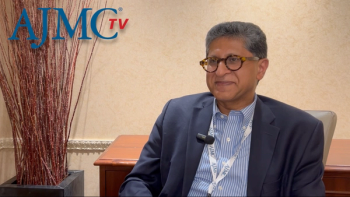
- August 2020
- Volume 26
- Issue 7
Best Cancer Tests Don't Reach All Who Need Them
Evidence-Based Oncology managed care updates for August 2020 feature coverage of liquid biopsies, companion diagnostics, and CAR T-cell therapy.
Companion Diagnostics in NSCLC Offer Substantial Survival Benefit, but Some Patients Still Miss Out
Paitents with non-small cell lung cancer (NSCLC) who received a companion diagnostic as part of their initial treatment had a 3-fold greater survival benefit than those who were not tested—yet some patients still don’t get tested.
That is what authors found in a study published July 6, 2020, in The Oncologist. The investigators, who reported the study was the largest real-world study of its kind, said it confirms the frustration that surrounds precision medicine in cancer care.1
“Despite level 1 evidence supporting the benefits of biomarker-driven therapeutic approaches and consensus among national and international guidelines for the routine use of [companion diagnostic] testing in NSCLC, it is not clear whether this evidence has translated to practice in real-world settings,” the authors wrote.
The results are based on an analysis of information from the Flatiron Health database using patient records from 2011 to 2018. The authors are from divisions of Roche and from Peter MacCallum Cancer Centre in Australia. Roche funded the study; it acquired Flatiron for $1.9 billion in 2018.2
What impacts who gets tested and who does not? Authors say the data show women are more likely to be tested than men, smokers are less likely to be tested than nonsmokers, and Asians as a group are likely to be tested.
The study found that as of May 31, 2018, only 14,732 patients with nonsquamous NSCLC received a companion diagnostic test out of 33,742 adult patients eligible for testing in the Flatiron Health database. However, the percentage who received testing increased significantly over time: Only 21.7% of eligible patients with nonsquamous NSCLC were tested from 2011 to 2013, and 62.2% of these patients were tested from 2014 to 2018.
Companion diagnostic (CDx) testing identifies patients most likely to benefit from biomarker-driven treatments. Much of the promise in lung cancer treatment comes from use of testing to match patients with targeted therapies, checkpoint inhibitors, or combinations. The 2020 American Society of Clinical Oncology Virtual Scientific Program featured the CITYSCAPE3 and ADAURA4 trials that relied on testing.
Most of the study focused on results for 17,555 patients who met the study’s analysis criteria. These patients had nonsquamous advanced NSCLC and were classified into 1 of 2 groups: the CDx group (n = 14,732) were those who tested for 1 of 4 driver mutations (ALK, BRAF, EGFR, or ROS1 positive or negative) analysis criteria. These patients had nonsquamous advanced NSCLC and were classified into 1 of 2 groups: the CDx group (n = 14,732) were those who tested and/or PD-L1 expression according to the Flatiron data; the no-CDx group (n = 2823) were those who did not have reported evidence of testing, including no CDx test or testing status unknown.
The patients had a mean age at diagnosis of 67.2 years, and two-thirds were white (67.1%). Most had insurance (91.7%). Among those tested, the median time from diagnosis to the first test was 19.0 days, and the median time from advanced diagnosis to first-line treatment was 33 days.
Differences between those tested and those not tested included the following:
• More patients in the CDx group (49.4%) received more than 1 line of therapy than patients in the no-CDx group (24.9%).
• In the CDx group, 75.9% had received test results before or at the start of treatment.
• Regional differences were seen: Patients living in the Northeast or West were more likely to get CDx tests than patients in the Midwest, with point estimate 1.30 (95% CI, 1.13-1.50) and 1.34 (95% CI, 1.15-1.57), respectively.
• Smokers were less likely to be tested than nonsmokers, with a point estimate of 0.35 (95% CI, 0.29-0.41).
• Although not many Asian patients were in the study (n = 473), Asians were more likely to be tested than White patients, with a point estimate of 2.55 (95% CI, 1.56-4.18).
Being tested meant living longer: Patients with CDx testing had a longer median survival than those without (95% CI) at 13.04 months (range, 12.62-13.40) vs 6.01 months (range, 5.72-6.24). Patients with testing also had decreased mortality risk (unadjusted HR, 0.54; 95% CI, 0.52-57).
When patients had CDx testing and biomarker-driven therapy as their first-line treatment, the results were even more remarkable compared with those who did not have testing: Median survival was 18.00 months (range, 16.66-19.22) vs 6.01 (range, 5.72-6.24). Patients who had their first CDx on or prior to first-line treatment also had a longer median overall survival than those not tested (12.78 vs 6.01 months; 95% CI).
“Since the prognosis for patients with advanced NSCLC is generally very poor, a dire need exists for earlier initiation of care through diagnostic testing and biomarker-driven treatment strategies. Based on this, it is evident that a standard ‘one size fits all’ approach in the treatment of cancer and many other disease areas does not always result in optimal patient outcomes,” the authors concluded.
“Precision medicine, in contrast, is an expanding treatment approach that can help match patients to the most effective treatments sooner based on an individual’s characteristics, including specific molecular targets likely to respond to biomarker-driven therapies.”
References
1. John A, Shan RA, Wong WB, Schneider CE, Alexander M. Value of precision medicine in advanced non-small cell lung cancer: real-world outcomes associated with the use of companion diagnostics. Oncologist. Published online July 6, 2020. doi:10.1634/theoncologist.2019-0864
2. Roche completes acquisition of Flatiron Health. News release. Roche. April 6, 2018. Accessed July 15, 2020. https://www.roche.com/media/releases/med-cor-2018-04-06.htm
3. Rodriguez-Abreu D, Johnson ML, Hussein MA, et al. Primary analysis of a randomized, double-blind, phase II study of the anti-TIGIT antibody tiragolumab (tira) plus atezolizumab (atezo) versus placebo plus atezo as firstline (1L) treatment in patients with PD-L1-selected NSCLC (CITYSCAPE). J Clin Oncol. 2020;38(suppl 15):9503. doi:10.1200/JCO.2020.38.15_suppl.9503
4. Herbst RS, Tsuboi M, John T, et al. Osimertinib as adjuvant therapy in patients (pts) with stage IB–IIIA EGFR mutation positive (EGFRm) NSCLC after complete tumor resection: ADAURA. Presented at: 2020 ASCO Virtual Scientific Program; May 28, 2020. Accessed July 17, 2020. https://meetinglibrary.asco.org/record/191929/abstract
Results in JNCCN Find Payer Coverage for Liquid Biopsies Improves, Gaps Remain
The role of circulating tumor DNA (ctDNA) in cancer care has advanced quickly over the past 5 years, allowing doctors to select targeted therapies or identify why treatments aren’t working. To some degree, payer coverage has followed, but it has lagged in important ways, according to research published in JNCCN—the Journal of the National Comprehensive Cancer Network.1
The National Comprehensive Cancer Network (NCCN) is a group of cancer centers that develops treatment guidelines considered to be the “gold standard” for payers.
Because coverage for ctDNA-based testing panels, also known as “liquid biopsies,” can dictate access, authors from the University of California San Francisco (UCSF) and City of Hope in Duarte, California, examined how coverage had changed over time as clinical adoption increased.
Using the Canary Insights database to analyze 40,000 medical policies from both commercial and public payers, the authors found that coverage increased 38% between January 1, 2015, and July 1, 2019.
Highlights of their findings include the following:
• None of the policies provided coverage in 2016, but 38% did by mid-2019.
• The scope of policies increased from a single cancer type in 2017 to 12 types of cancer and from a single gene to 73 genes.
• The review found a trend toward use of testing across all cancer types, which the authors described as “an important shift.”
• Forty-five payers had specific policies barring coverage.
“Genomic ctDNA or liquid biopsy tests hold great potential to improve patient outcomes, although, as with any emerging test, it can be challenging to develop the most appropriate coverage policies,” said lead investigator Michael P. Douglas, department of Clinical Pharmacy, UCSF Center for Translational and Policy Research on Personalized Medicine, said in a statement.2 “We think that the increased coverage, especially Medicare coverage of pan-cancer use, will expand the use of liquid biopsy in clinical practice in the future. The hope is that results in more targeted care with better treatment and diagnostic options, leading to long-term benefits.”
The investigators noted a difference between the highly specific nature of policies in private plans compared with draft and future-effective local coverage determinations with Medicare Administrative Contractors, which offer policies that will cover Medicare beneficiaries and testing across different cancer types (pan-cancer use). Among the private plans, 87% were for non–small cell lung cancer (NSCLC), 47% were for EGFR testing, and 79% were for specific brand-name tests.
The authors describe the “conundrum” in payer coverage given how these blood-based tests are used. The ctDNA test can be used at the time of diagnosis to find genomic alterations to direct targeted therapy and if the disease progresses to determine “the mechanism of therapeutic resistance.”
A blood-based assay is faster and easier than a tissue-based test, and sometimes tissue-based tests are unavailable, the authors wrote. They concluded, “Given that genomic medicine is rapidly changing, payers and policymakers (eg, guideline developers) will need to continue to evolve policies to keep pace with emerging science and standards in clinical care.”
“The NCCN Guidelines for Non–Small Cell Lung Cancer currently state that ctDNA testing can be considered for monitoring purposes when a patient with a confirmed lung cancer diagnosis is medically unfit for invasive tissue sampling,” said David S. Ettinger, MD, of The Sidney Kimmel Comprehensive Cancer Center at Johns Hopkins, who chairs the NCCN Guidelines for NSCLC panel. Ettinger was not involved with this study.
“Although coverage is expanding, it still takes too long to adapt policies, which often vary from state to state,” he said. “We recommend specific testing be conducted as part of a broad molecular profiling, at least for advanced or metastatic disease.”
Ettinger said a liquid biopsy can take less time than a diagnosis based on a tissue sample, and if positive, the liquid results are “unambiguous” and can direct clinical decision-making. If negative, there is a 30% chance the ctDNA results are not accurate, so a tissue sample should follow.
References
1. Douglas MP, Gray SW, Phillips KA. Private payer and Medicare coverage for circulating tumor DNA testing: a historical analysis of coverage policies from 2015 to 2019. J Natl Compr Canc Netw 2020;18(7):866-872. doi:10.6004/jnccn.2020.7542
2. JNCCN study explores if insurance is keeping pace with trends in targeted cancer therapy. News release. National Comprehensive Cancer Network. July 7, 2020. Accessed July 15, 2020. https://www.nccn.org/about/news/newsinfo.aspx?NewsID=2189
NCCN Patient Guidelines Highlight Adverse Effects of Immunotherapy, CAR T-Cell Therapy
Although immunotherapy has become an important treatment option for some cancers and is often well tolerated, it can have different adverse effects (AEs) than traditional approaches, such as chemotherapy. The National Comprehensive Cancer Network (NCCN) recently released a new set of guidelines to help patients and caregivers understand the unique and severe AEs of immune checkpoint inhibitors (ICIs), a common type of immunotherapy.1
The patient guidelines provide information on the evidence-based, expertconsensus clinical practice guidelines used by health care providers—but in consumer-friendly language so patients and caregivers can better understand treatment options.
“Immune checkpoint inhibitors have revolutionized our approach to the treatment of cancer,” John A. Thompson, MD, professor of medicine at the University of Washington and chair of the NCCN Guidelines for Management of Immunotherapy-Related Toxicities panel, said in a statement.2 “ICIs are now approved by the FDA for treating more than a dozen forms of cancer, and the list is growing every year. However, by virtue of stimulating the patient’s immune white blood cells, ICI therapy sometimes causes serious [adverse] effects that mimic autoimmune disease, including significant rash and/or inflammation of the thyroid, liver, lungs, nervous system, glandular system, heart, or other organs.”
The guideline explains that immune-related AEs can start during or after immunotherapy, but most can be managed if identified and treated early. NCCN also released patient guidelines on the AEs of chimeric antigen receptor (CAR) T-cell therapy. Olalekan Oluwole, MD, of Vanderbilt-Ingram Cancer Center and a member of the NCCN Guidelines for Management of Immunotherapy-Related Toxicities panel, explained that traditional chemotherapy attacks all cells and can leave patients with long-term complications, such as other forms of cancer, but CAR T-cell therapy attack cancer cells in a different and more targeted way.
“The targeting is akin to a heat-seeking missile that won’t stop until it takes out any cell with the target, leading to potential long-term or permanent remission,” Oluwole said in a statement.2 “CAR T is given one time, unlike chemotherapy, which is given over multiple cycles and could go on for months or years. However, patients are often surprised to learn that the single CAR T infusion includes a 28-day monitoring period during which they need to stay in close proximity to their treatment center.”
Patients are monitored for cytokine release syndrome (CRS) and immune effector cell-associated neurotoxicity syndrome (ICANS). In CRS, immune cells affected by the treatment release cytokines into the blood, which creates an intense systemic inflammatory response. In ICANS, there are a range of neurological AEs. However, both CRS and ICANS can be reversed if treated promptly, which is why patients are monitored closely following treatment.
“CRS can set in rapidly, pushing the patient’s body to very high temperatures and taking quite a toll,” said Oluwole. “However, we researchers are learning more about how to collaborate to predict toxicities and sharing knowledge on recognizing and treating them more quickly. The new NCCN Guidelines for Patients are yet another example of how we’re sharing this important information.”
References
1. NCCN. NCCN Guidelines for Patients. Immunotherapy side effects: immune checkpoint inhibitors. Accessed July 15, 2020. https://www.nccn.org/patients/guidelines/content/PDF/immunotherapy-se-ici-patient.pdf
2. How to recognize side-effects from immunotherapy? New NCCN Guidelines for Patients can help News release. National Comprehensive Cancer Network. June 29, 2020. Accessed July 17, 2020. https://www.nccn.org/about/news/newsinfo.aspx?NewsID=2179
OneOncology Appoints John Fox, MD, Medical Director of Managed Care
OneOncology, a national partnership of independent oncology practices, announced on July 20, 2020, the appointment of John Fox, MD, as medical director of managed care. In his role, Fox will work with OneOncology partner practices to develop, evolve, and maintain value-based contracts with commercial and public payers.
“As the transition from fee-for-service to value-based contracts continues, Dr Fox will play an integral role in supporting partner practices to develop and optimize value-based care to achieve Quadruple Aim goals,” said Jeff Patton, MD, OneOncology’s CEO.
OneOncology is a Strategic Alliance Partner of The American Journal of Managed Care®. Fox is a member of the editorial board of Evidence-Based Oncology™.
As community oncology practices transition to value-based care delivery through the implementation of alternative payment models, OneOncology supports its partner practices’ capacity for change through public policy advocacy and thought leadership, commercial health plan contract negotiation, and physician engagement and education initiatives.
OneOncology partner practices have collectively managed about 4500 episodes of care in each performance period of the Center for Medicare and Medicaid Innovation’s Oncology Care Model (OCM). OneOncology partner practices also participate in several commercial health plan value-based payment arrangements. OneOncology provides a scalable platform for generating insights, sharing best practices, and benchmarking key performance metrics among several of the most progressive practices in value-based care. “I’m excited to join OneOncology and apply my experience to help ensure that partner practices continue to succeed transforming from volume to value,” said Fox. “OneOncology has been at the forefront of understanding the OCM and helping to shape Medicare’s next value-based oncology care model. Applying our OCM experience and aligning through all commercial value-based contracts will help drive success for patients, providers, employers, and payers.”
Fox was most recently vice president and associate chief medical officer for medical affairs at Priority Health. His initiatives included shared decision-making, advanced care planning, integrated specialty pharmacy program and value-based benefit designs, and payment reform strategies, including oncology medical home initiatives and bundled payments.
Articles in this issue
over 5 years ago
Where Myths Go to Dieover 5 years ago
FDA Actions Include Third CAR T-cell Therapyover 5 years ago
Choice Is Vital to Biosimilar Savings Picture, Panelists Sayover 5 years ago
MRD, Biomarkers in Multiple Myelomaover 5 years ago
Hospitals Vow to Fight Court of Appeals 340B RulingNewsletter
Stay ahead of policy, cost, and value—subscribe to AJMC for expert insights at the intersection of clinical care and health economics.





























































